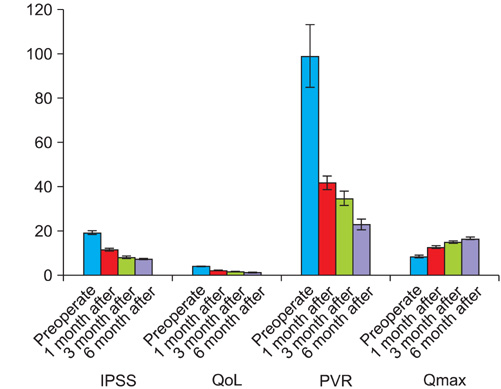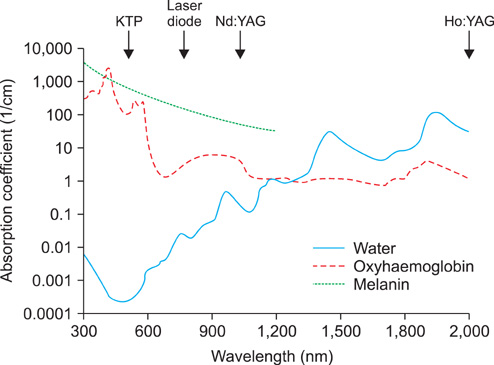Korean J Urol.
2011 Nov;52(11):752-756.
Initial Experiences with a 980 nm Diode Laser for Photoselective Vaporization of the Prostate for the Treatment of Benign Prostatic Hyperplasia
- Affiliations
-
- 1Department of Urology, Maryknoll Hospital, Busan, Korea. ggochis@hanmail.net
- 2Department of Urology, Boomin Hospital, Busan, Korea.
Abstract
- PURPOSE
This study was conducted to analyze the efficacy of photoselective vaporization of the prostate (PVP) with the use of a 980 nm diode laser for benign prostatic hyperplasia (BPH) according to postoperative period.
MATERIALS AND METHODS
Data were collected from 96 patients who were diagnosed with BPH and who underwent PVP with the 980 nm K2 diode laser. Postoperative parameters, including International Prostate Symptom Score (IPSS), quality of life (QoL) score, maximum urinary flow rate (Qmax), and post-void residual volume (PVR), were assessed and compared with preoperative baseline values.
RESULTS
The mean prostate volume was 45.3+/-15.6 g, the mean operative time (lasing time) was 22.9+/-18.3 minutes, the total amount of energy was 126+/-84 kJ, and the Foley catheter maintenance period after PVP was 24.8+/-5.6 hours. At 1 month, significant improvements were noted in IPSS (11.7+/-6.6), QoL score (2.3+/-1.1), Qmax (12.7+/-6.1 ml/sec), and PVR (41.9+/-30.5 ml). After 3 months, all follow-up parameters showed significant improvements that were sustained throughout a period of 6 months after PVP.
CONCLUSIONS
PVP using a K2 diode laser is a minimally invasive and effective surgical method for improvement of BPH and is associated with minimal morbidity.
Keyword
MeSH Terms
Figure
Reference
-
1. McNeal J. Pathology of benign prostatic hyperplasia insight into etiology. Urol Clin North Am. 1990. 17:477–486.2. Madersbacher S, Alivizatos G, Nordling J, Sanz CR, Emberton M, de la Rosette JJ. EAU 2004 guidelines on assesment, therapy and follow-up of men with lower urinary tract symptoms suggestive of benign prostatic obstruction (BPH guidelines). Eur Urol. 2004. 46:547–554.3. Rassweiler J, Teber D, Kuntz R, Hofmann R. Complications of transurethral resection of the prostate (TURP)-incidence, management, and prevention. Eur Urol. 2006. 50:969–979.4. Mebust WK, Holtgrewe HL, Cockett AT, Peters PC. Transurethral prostatectomy: immediate and postoperative complications. A Cooperative study of 13 participating institutions evaluating 3,885 patients. J Urol. 1989. 141:243–247.5. Reich O, Gratzke C, Bachmann A, Seitz M, Schlenker B, Hermanek P, et al. Morbidity, mortality and early outcome of transurethral resection of the prostate: a prospective multicenter evaluation of 10,654 patients. J Urol. 2008. 180:246–249.6. Donovan JL, Peters TJ, Neal ED, Brookes ST, Gujral S, Chacko KN, et al. A randomized trial comparing transurethral resection of the prostate, laser therapy and conservative treatment of men with symptoms associated with benign prostatic enlargement: the CLasP study. J Urol. 2000. 164:65–70.7. Te AE, Malloy TR, Stein BS, Ulchaker JC, Nseyo UO, Hai MA, et al. Photoselective vaporization of the prostate for the treatment of benign prostatic hyperplasia: 12-month results from the first United States multicenter prospective trial. J Urol. 2004. 172:1404–1408.8. Bachmann A, Schurch L, Ruszat R, Wyler SF, Seifert HH, Muller A, et al. Photoselective vaporization (PVP) versus transurethral resection of the prostate (TURP): a prospective bi-centre study of perioperative morbidity and early functional outcome. Eur Urol. 2005. 48:965–971.9. Spaliviero M, Araki M, Page JB, Wong C. Catheter-free 120W lithium triborate (LBO) laser photoselective vaporization prostatectomy (PVP) for benign prostatic hyperplasia (BPH). Lasers Surg Med. 2008. 40:529–534.10. Reich O, Bachmann A, Siebels M, Hofstetter A, Stief CG, Sulser T. High power (80W) potassium-titanyl-phosphate laser vaporization of the prostate in 66 high risk patients. J Urol. 2005. 173:158–160.11. Sarica K, Alkan E, Lüleci H, Taşci AI. Photoselective vaporization of the enlarged prostate with KTP laser: long-term results in 240 patients. J Endourol. 2005. 19:1199–1202.12. Volkan T, Ihsan TA, Yilmaz O, Emin O, Selcuk S, Koray K, et al. Short term outcomes of high power (80W) potassium-titanyl-phosphate laser vaporization of the prostate. EUR Urol. 2005. 48:608–613.13. Sulser T, Reich O, Wyler S, Ruszat R, Casella R, Hofstetter A, et al. Photoselective KTP laser vaporization of the prostate: first experiences with 65 procedures. J Endourol. 2004. 18:976–981.14. Ruszat R, Wyler SF, Seitz M, Lehmann K, Abe C, Bonkat G, et al. Comparison of potassium-titanyl-phosphate laser vaporization of the prostate and transurethral resection of the prostate: update of a prospective non-randomized two-centre study. BJU Int. 2008. 102:1432–1439.15. Bouchier-Hayes DM, Van Appledorn S, Bugeja P, Crowe H, Challacombe B, Costello AJ. A randomized trial of photoselective vaporization of the prostate using the 80-W potassium-titanyl-phosphate laser vs transurethral prostatectomy, with a 1-year follow-up. BJU Int. 2010. 105:964–969.16. Kang SH, Choi SY, Kim SJ, Cho HJ, Hong SH, Lee JY, et al. Long-term follow-up results of photoselective vaporization of the prostate with the 120 W greenlight HPS laser for treatment of benign prostatic hyperplasia. Korean J Urol. 2011. 52:260–264.17. Seitz M, Sroka R, Gratzke C, Schlenker B, Steinbrecher V, Khoder W, et al. The diode laser: A novel side firing approach for laser vaporisation of the human prostate-immediate efficacy and 1-year follow-up. Eur Urol. 2007. 52:1717–1722.18. Wendt-Nordahl G, Huckele S, Honeck P, Alken P, Knoll T, Michel MS, et al. 980-nm Diode laser: A novel laser technology for vaporization of the prostate. Eur Urol. 2007. 52:1723–1728.19. Erol A, Cam K, Tekin A, Memik O, Coban S, Ozer Y. High power diode laser vaporization of the prostate: preliminary results for benign prostatic hyperplasia. J Urol. 2009. 182:1078–1082.20. Ruszat R, Seitz M, Wyler SF, Mller G, Rieken M, Bonkat G, et al. Prospective single-centre comparison of 120-W diode-pumped solid-state high-intensity system laser vaporization of the prostate and 200-W high-intensive diode-laser ablation of the prostate for treating benign prostatic hyperplasia. BJU Int. 2009. 104:820–825.21. Seitz M, Reich O, Gratzke C, Schlenker B, Khoder W, Fischer F, et al. High-power diode laser at 980 nm for the treatment of benign prostatic hyperplasia: ex vivo investigations on porcine kidneys and human cadaver prostates. Lasers Med Sci. 2009. 24:172–178.
- Full Text Links
- Actions
-
Cited
- CITED
-
- Close
- Share
- Similar articles
-
- Twelve-Month Follow-up Results of Photoselective Vaporization of the Prostate With a 980-nm Diode Laser for Treatment of Benign Hyperplasia
- Outcome of 980 nm diode laser vaporization for benign prostatic hyperplasia: A prospective study
- The Evolution of KTP Laser Vaporization of the Prostate
- Recent advances in laser treatment for benign prostatic hyperplasia
- Potassium-Titanyl-Phosphate Laser Photoselective Vaporization of the Prostate in Patients with Benign Prostatic Hyperplasia with Detrusor Underactivity: Influence on Detrusor Pressure



